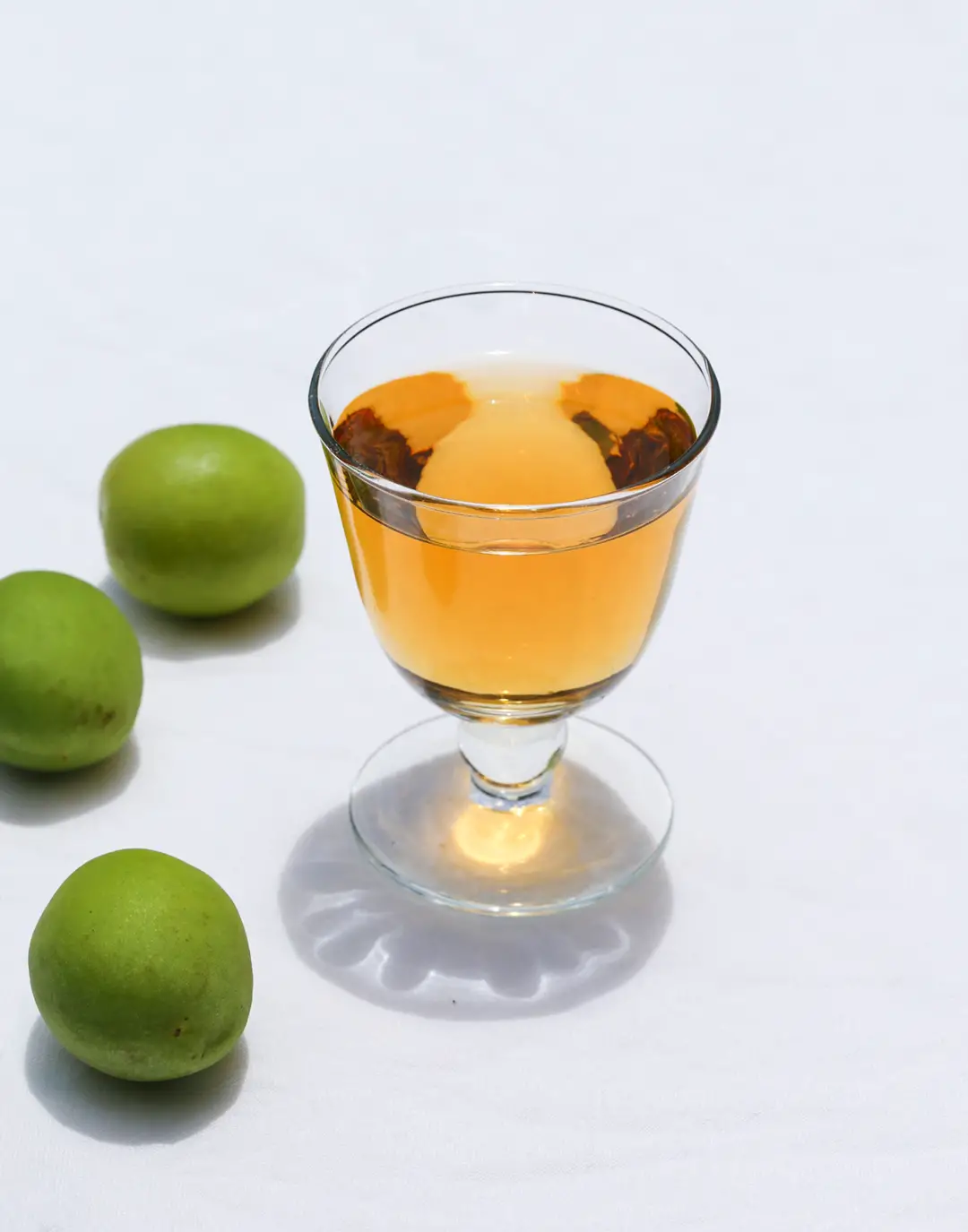
This is my mother’s Japanese plum wine (Umeshu) recipe. Making plum wine is her annual event in June and this was my first time to make it together. I really enjoyed it and also found out how easy to make it. All my family loves her variety of plum wines preserved every year. They are beautiful clear amber color with full of aroma. I will show you how to make the best homemade Japanese plum wine with her tips.
How to make Japanese Plum wine (Umeshu)
You need only 3 ingredients below, plus a glass jar.
- Plums
- Sugar
- Hard liquor
Flesh green plums
Japanese plum wine calls for unripe fresh green plum. A common variety of plum used for plum wine is called Nanko-ume (南高梅) in Japan.
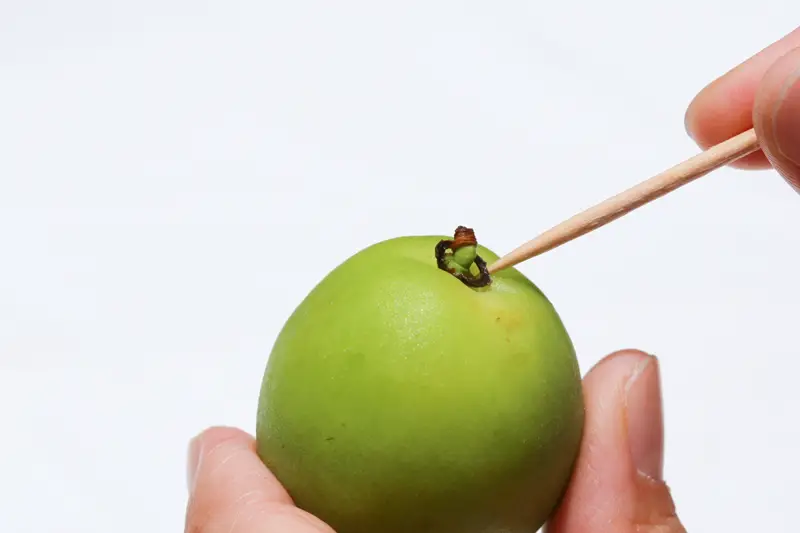
I’m not sure where good quality of green plums available outside of Japan, though many Japanese plum wine recipe suggests to go to Japanese / Korean grocery stores and it’s sold as Japanese / Chinese green plums.
When you find green plums, choose the one like below.
- Flesh
- Smooth
- No wrinkles
- No oozing spots
- Light green
- Large
Flesh and the right ripeness for plum wine is light green and smooth on the surface. You can feel fuzz of the plums and the thick flesh. If there are wrinkles, it’s too early and yellow plums are too ripened. Also, choose green plums as big as possible. Because bigger plums are, the more juice to be extracted. In this recipe, we used plums about 3.8 cm (1.5 inch) in diameter.
Oh, I have to tell you one more thing. Once you get the green plums, don’t eat straight from the package, it causes stomachache ache.
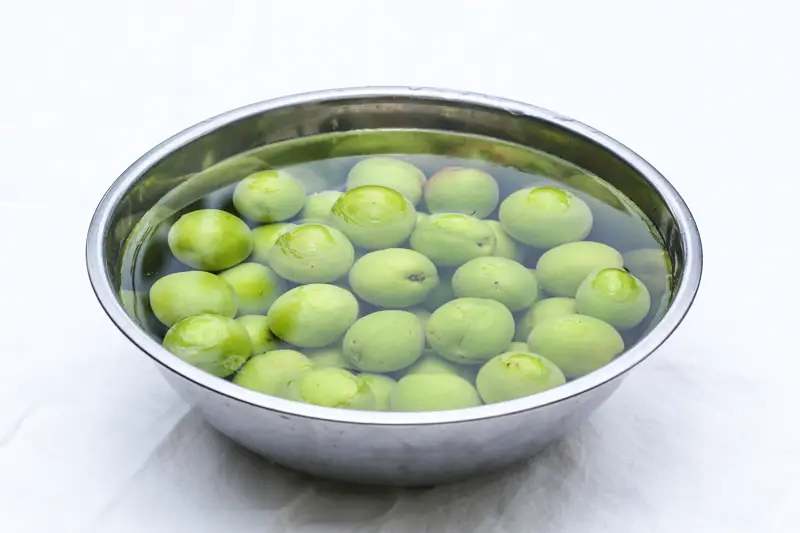
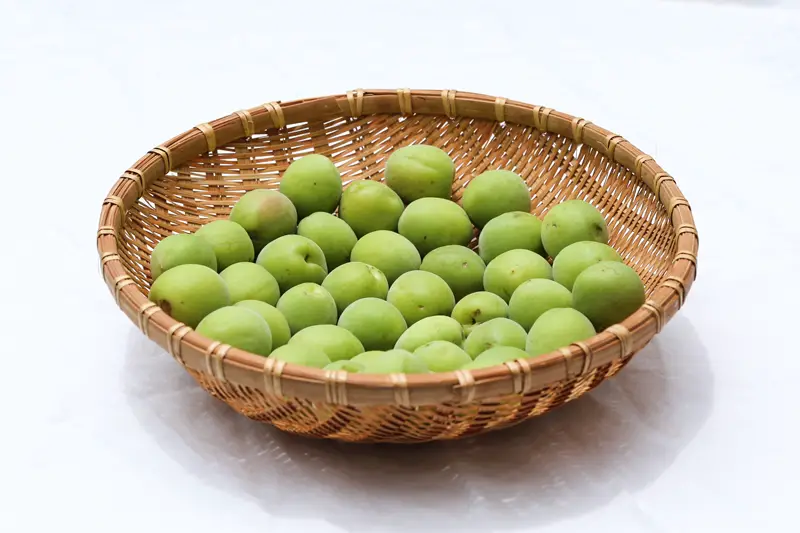
White rock sugar
How does it work?
Another important ingredient of Japanese plum wine is white rock sugar. I hope you will also get it at Asian grocery stores. But if you cannot prepare, you can replace it with white granulated sugar. However rock sugar has 2 benefits (see below) to use as it dissolves more slowly than table sugar.
- The plums are well sterilized by high alcohol of the hard liquor until the rock sugar completely dissolved.
- Gradual rise of concentration of sugar in liquid brings out the more plum extract and gives mild taste.
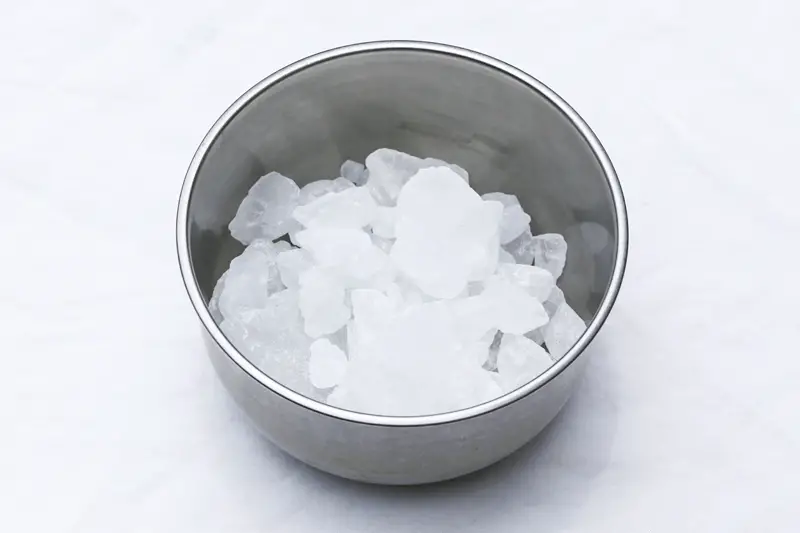
Sugar content
Sugar content of plum wine is various depending on the recipe. So here is a basic guide of sugar content to use liquor of 1.8L.
- 500-600 g – semi-sweet
- 700-800 g – sweet (standard amount)
- 900 g – 1 kg – very sweet
I indicated sweetness with the word “sweet”, but don’t grasp the meaning like sweetness of normal wine. Japanese plum wine is completely different from normal wine, which is basically very sweet and the sweetness closer to fruit juice. If you usually prefer unsweetened liquor, it might be hard to consume a glass of the plum wine if it’s containing standard sugar amount, in my experience.
So thus, 500 g of rock sugar is the best amount of Japanese plum wine, in our opinion. It gives gentle sweetness while still pulling out the enough plum extract. We also think 500 g of sugar is a minimum amount. Because you need a certain amount of sugar to activate osmotic pressure of sugar, in order to pull out the enough aroma and taste in plums. She has made it with less than 500 g sugar, though it was too tart and the taste was too light.
Hard liquor
A standard liquor for Japanese plum wine is definitely white liquor as Japanese most famous plum wine company Choya mainly use it. It’s almost flavorless and scentless by distillation many times. That is because that white liquor is the liquor to make fruit wine. Other than white liquor, there is a variety of plum wine with different liquor made: Sake, whiskey, brandy, rum and more. You can use any liquor as long as above 35% ABV alcohol by volume.
By the way, our favorite is white rum at all time (second is brandy). The gentle sweet flavor of rum makes the plum wine so good. We love the well balanced richness and refreshing taste along with complex sweet flavor. If you like rum raisin dessert, ice cream or cheesecake, you could imagine how amazing it is!
If you like to try different types of liquor, it might be a good idea to divide the ingredients in half to pour two kinds of liquor.
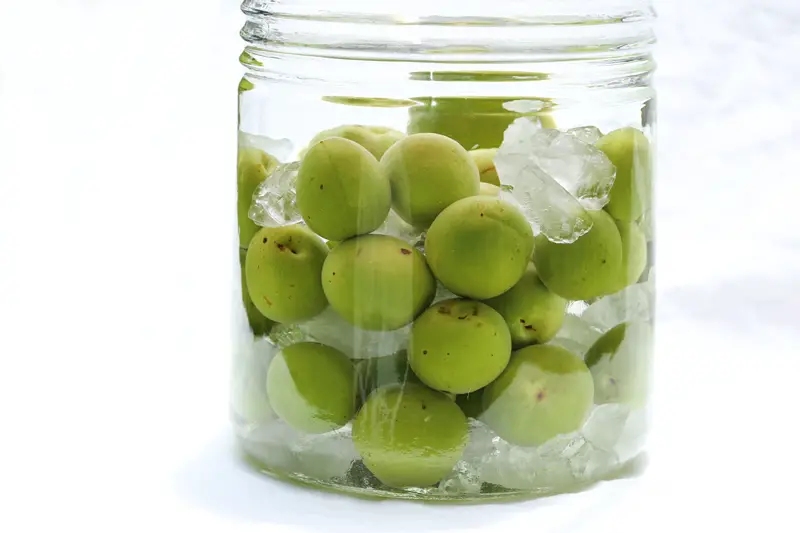
How long does Japanese Plum wine last?
There is no expiration date of homemade Japanese plum wine. If you store properly, you can drink for over 30 years. When you feel strange smell or weird tastes, it’s time to throw it away.
Here are the tips to keep your plum wine good condition.
- Dry or wipe off any moisture on the surface of the plums before placing in a glass jar.
- Store in a cool, dark place away from direct sunlight. But not in the fridge.
- Use a GLASS jar (not plastic) that can be tightly sealed.
How to drink Japanese Plum wine?
The most popular way to drink Japanese plum wine is on the rocks (my favorite!). During the summer season, I sometimes add soda to refresh myself. If you would like to know another way to drink, this drink recipes on Choya website can be useful!
Also, I think the refreshing plum wine is nice to pair with crispy deep-fried dishes like my Chicken Karaage (Japanese fried chicken) or Chicken Katus (cutlet). If you would like to, please take a look!
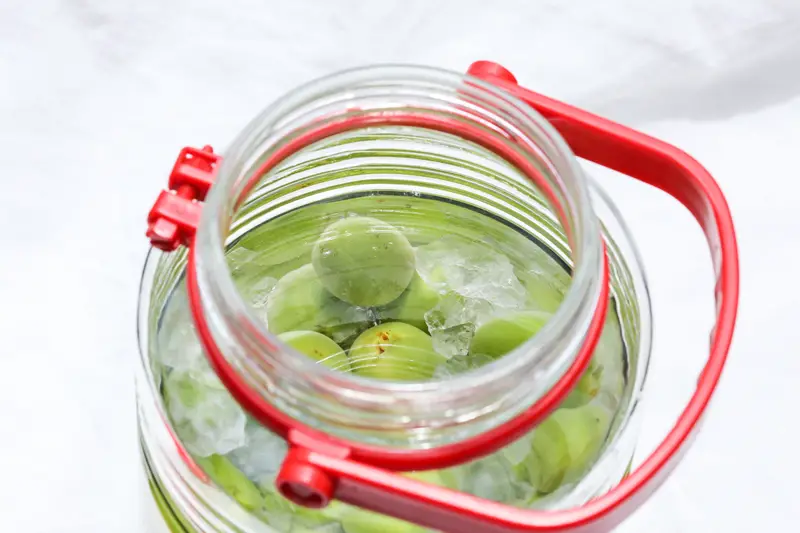
See you next year, my lovely Umeshu! And I hope you enjoy making it!
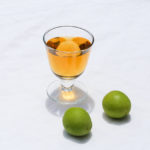
Best Homemade Japanese Plum Wine (Umeshu)
Ingredients
- 1 kg (2.2 lb) green plums
- 500 g (1.1 lb) white rock sugar
- 1.8 L white rum above 35% ABV alcohol by volume
Other
- 4 L glass jar
Instructions
- Gently rinse the plums and soak in water for at least 4 hours to overnight.
- Drain the water and spread the plums over a large strainer or clean dish towels, arranging not to be overlapped. Leave them in well-ventilated area at home until the surface of the plums completely dried.
- Wipe off the moisture on the surface of the plums with clean paper towels, if any. Then remove the stems of the plums with a toothpick. Be careful not to scratch the surface of the plums.
- Damp the clean paper towel with hard liquor of your choice (I used some of the white rum) and wipe inside the jar.
- Place a layer of plums, then a layer of rock sugar in the jar. Repeat the process with the remaining.
- Pour 1.8 L of the white rum and seal the lid. Label today's date on the jar, and store in a cool, dark place with completely no light. (Not in the fridge)
- You can start drinking after 6 months but I recommend to wait for a whole year. Because the more you wait, the better taste you can drink.
- Take out the plums after a year later.
Notes
- You can eat the plums but it has really strong alcohol smell.
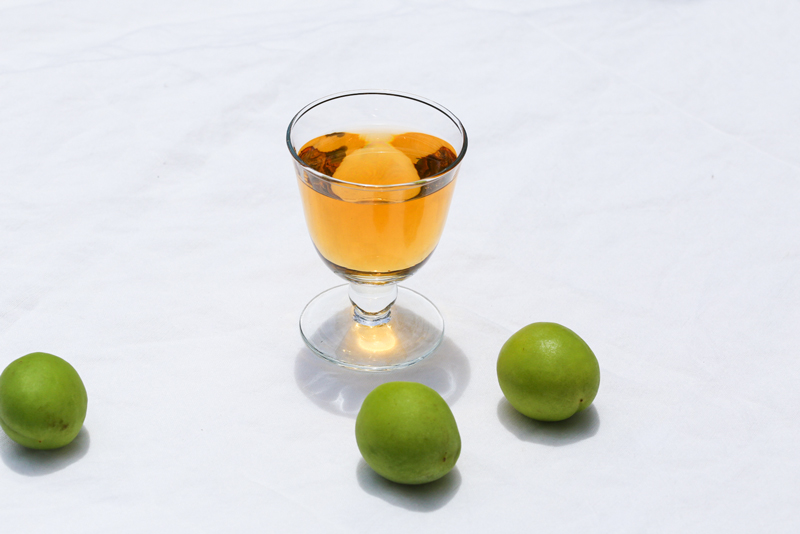
19 comments
Hi! May I know the type/brand of white rum you use? I’d like to try diff variations besides shochu but not sure which white rum brand to purchase 😅
Hi, thank you for your comment! but i’m sorry that I don’t remember which brand rum I bought when I made the plum wine. I only remember that I chose cheepest one at the store. I think no problem to make with any kind of rum.
Thank you for replying!! 🙂
[…] instead of shochu (焼酎). You can make it with any type of hard liquor, though! Here’s a great recipe for making your own […]
Hi, can I use canning jar to store ? And where do I buy the glass container with a seal in your picture?
Tq for your recipe .
Hi, you can use canning jars, also flip top storage jars. My seal is the same as the jar in the link. https://www.amazon.com/Airtight-Bulk-dry-BPA-Free-Dishwasher-Fermenting/dp/B084YRKWHN
If you are in Japan, please search 梅酒 瓶!
I would recommend using Everclear from the liquor store. It’s 190 proof (95%, almost pure) alcohol, but if you add 2 parts water to 1 part Everclear this reduces it to a 32% alcohol level. It might seem strange, but this is how distillers make ethanol to have a specific proof or %; they add water. You need a separate container to add the water and Everclear together by giving it a really good shaking to mix them together thoroughly. It’s very cost efficient this way. I pay about $35 for a 1.8L bottle of Everclear, which then makes 5.4L of 32% alcohol after 2 parts water is added. You can obviously adjust the percentage by altering how much water you add.
I made 16L of ume-shu this year. The hardest part is waiting for a whole year, but I mostly enjoy giving it to my Japanese (mostly lady) friends as a gift since I prefer drinking shochu or nihonshu more myself.
Hope this helps.
I really appreciate the variations you described.
It’s my pleasure!
Where are you glasses from? So pretty!
Thank you! It’s may be made from Hoya, a Japanese glass company. But I bought it many years ago and I couldn’t find the same glasses on the website.
For anyone who is looking for fresh ume plums, this person sells every year by word of mouth: https://bit.ly/OrderUmeHere2020
Thank you for sharing!
Do you have an online store?
I’m sorry, but I don’t have an online store.
I tried making this last year and it’s been a year now so ready to drink it! Question: if I want to open it and try some, can I seal it back up and store it again? If so, for how long can I keep it for and what’s the best way to store it?
I sort of want to keep a portion of it to try again in a couple years to see how the taste develops but wasn’t sure if it worked liked that.
Thank you for trying the recipe! You can seal it back up after tasting. Make sure to use a clean ladle to scoop the Umesh up into your glass. There is no expiration date of homemade Japanese plum wine. It might sound like an exaggeration, but you can drink for over 30 years. When you feel strange smell or weird tastes, it’s time to throw it away. Please store in a cool, dark place away from direct sunlight. But not in the fridge. I store mine in the cabinet in the kitchen. Also, there is no correct answer for the right time to take the plums out of the container, but I recommend taking them out in 3 years. Because the plums get mushy and will cause to spoil your Umesh. I hope it will help!
Have you tried using ripe-overripe or sliced in half plums before? I’m curious why ripe ones wouldn’t be used since they would have a high concentration of natural sugars?
I’m so excited to try this for the first time this year!!
Thank you for stopping by my blog! I (my mother) have never made umeshu with ripe plums before, though it’s possible to make it with ripe yellow plums. Some people prefer the umeshu made with ripe plums. Because it’s more mellow and less sour. But I’ve never heard of using over-ripe or sliced plums. I guess that ripe plums tend to mushy while pickling, so normally homemade umeshu use unripe green plums. I hope this will help!